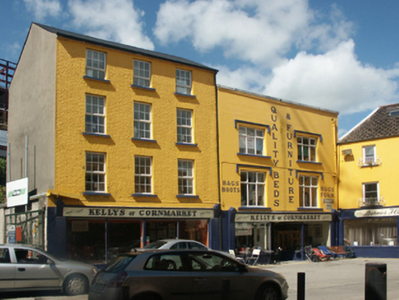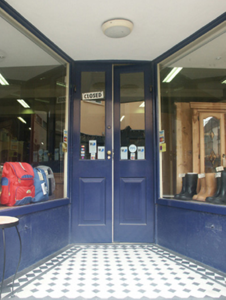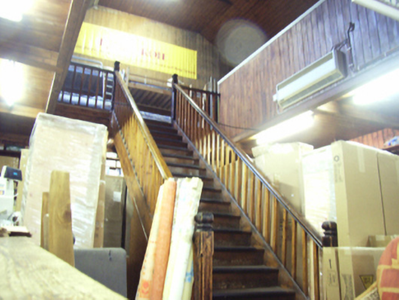Survey Data
Reg No
15503094
Rating
Regional
Categories of Special Interest
Architectural, Historical, Social
Original Use
Shop/retail outlet
In Use As
Shop/retail outlet
Date
1800 - 1840
Coordinates
304801, 121987
Date Recorded
16/06/2005
Date Updated
--/--/--
Description
Attached two-bay three-storey flat-roofed commercial building, extant 1840, on a rectangular plan with shopfront to ground floor. Renovated, ----. Flat roof not visible behind parapet with concealed rainwater goods retaining cast-iron octagonal or ogee hoppers and downpipes. Rendered, ruled and lined wall to front (south) elevation with iron-covered coping to parapet; rendered surface finish (remainder). Shopfront to ground floor on a symmetrical plan centred on glazed timber panelled double doors. Square-headed window openings originally in tripartite arrangement with cut-granite sills, and concealed dressings with hood mouldings on label stops framing replacement timber casement windows. Full-height interior centred on staircase with timber balusters supporting carved timber banisters terminating in chamfered timber newels, timber boarded gallery (first floor), and timber boarded vaulted ceiling. Street fronted.
Appraisal
A commercial building representing an integral component of the built heritage of Wexford with the architectural value of the composition, one repurposing 'a building which at the beginning of the nineteenth century was an independent church named Bethesda with Reverend Thomas Dillon as [its] pastor' (Kehoe 1985, 24), suggested by such attributes as the compact rectilinear plan form; the diminishing in scale of the openings on each floor producing a graduated visual impression with those openings originally showing multipartite glazing patterns; and the parapeted roofline. Having been well maintained, the elementary form and massing survive intact together with quantities of the original fabric, both to the exterior and to the galleried interior: however, the introduction of replacement fittings to most of the openings has not had a beneficial impact on the character or integrity of a commercial building forming part of a self-contained group alongside an adjoining house (see 15502020) with the resulting ensemble making a pleasing visual statement in a narrow street colloquially known as "The Gut". NOTE: Allegedly the theatre so described (1830) in "The Wexford Herald": "The opening of the Theatre on Tuesday evening with the comedy "Bull" and the farce "The Padlock" has excited unusual interest. The house is a palace now compared with what it has been; and we have no doubt that the performances will fully accord with the improvements in the building. The orchestra is under a skilful master of his profession. Four respectable actresses have arrived from London". The theatre closed owing to competition from the nearby Theatre Royal (1832).





